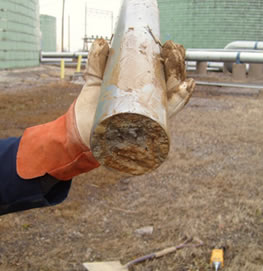- the California sampler
- Shelby tube
- and SPT sampler.
One of the most important first steps in sampling is to clean-out the bottom of the borehole in order to remove the loose soil or rock debris that may have fallen to the bottom of the borehole.
For soil, the most common method is to force a sampler into the soil by either
- hammering,
- jacking,
- or pushing
the sampler into the soil located at the bottom of the borehole.
TYPES OF SAMPLERS FOR SOILS
Soil samplers are typically divided into two types:
Thin-Walled Soil Sampler. The most common type of soil sampler used in the United States is the
Shelby tube, which is a thin-walled sampling tube consisting of stainless steel or brass tubing.
In order to slice through the soil, the Shelby tube has a sharp and drawn-in cutting edge.
In terms of dimensions, typical
- diameters are from 2 to 3 in. (5 to 7.6 cm)
- and lengths vary from 2 to 3 ft (0.6 to 0.9 m)
The typical arrangement of
- drill rod
- sampler head
- and thin-wall tube sampler
is shown in Fig. 2.11.
 |
| Shelby tube sampling |
 |
| Shelby tube sampler |
 |
| Shelby tube sample |
The sampler head contains a ball check valve and vents for escape of air and water during
the sampling process.
The drill rig equipment can be used to either :
- hammer
- jack
- or push
the sampler into the soil.
The preferred method is to slowly push the sampler into the soil by using hydraulic jacks or the weight of the drilling equipment.
Thin-walled soil samplers are used to obtain undisturbed soil samples
For further details on thin-walled sampling, see ASTM D 1587-00 (2004)
Thick-Walled Soil Sampler. Thin-walled samplers may not be strong enough to sample
- gravelly soils,
- very hard soils
- or cemented soils.
In such cases, a thick-walled soil sampler will be required.
Such samplers are often driven into place by using a drop hammer.
The typical arrangement of
- drill rod
- sampler head
- and barrel
when driving a thick-walled sampler is shown in Fig. 2.11.
Many localities have developed thick-walled samplers that have proven successful for local con-ditions.
For example, in southern California, a common type of sampler is the California sampler,
which is a split-spoon type sampler that contains removable internal rings,
1.0 in. (2.54 cm) in height.
Figure 2.10 shows the California sampler in an open condition, with the individual rings exposed.
The California sampler has a :
- 3.0 in. (7.6 cm) outside diameter
- and a 2.50 in. (6.35 cm) inside diameter.
This sturdy sampler, which is considered to be a thick-walled sampler, has proven successful in
sampling hard and desiccated soil and soft sedimentary rock common in southern California.
Another type of thick-walled sampler is the SPT sampler, which will be discussed in Sec. 2.4.3.
For further details on thick-walled sampling, see ASTM D 3550-01 (2004)
| SPT sampler |
 |
| SPT sampler |


Nice post. Thanks for sharing.
ReplyDeleteWhen Only the Best screw will do. When and where to save on piling costs with screw piles.
We provide services of Besment waterproofing, concrete repair, footings, subsidence, basement underpin articles, basement walls, retaining walls, shoring, spray concrete, underpinning, grout injection, house underpinning(sydney), underpinning services, foundation repairs, basement garages, house restumping and ventilation sub-floor.
helical pile